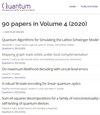Entanglement of Disjoint Intervals in Dual-Unitary Circuits: Exact Results
IF 5.1
2区 物理与天体物理
Q1 PHYSICS, MULTIDISCIPLINARY
引用次数: 0
Abstract
The growth of the entanglement between two disjoint intervals and its complement after a quantum quench is regarded as a dynamical chaos indicator. Namely, it is expected to show qualitatively different behaviours depending on whether the underlying microscopic dynamics is chaotic or integrable. So far, however, this could only be verified in the context of conformal field theories. Here we present an exact confirmation of this expectation in a class of interacting microscopic Floquet systems on the lattice, i.e., dual-unitary circuits. These systems can either have $zero$ or a $\textit{super extensive}$ number of conserved charges: the latter case is achieved via fine-tuning. We show that, for $almost$ all dual unitary circuits on qubits and for a large family of dual-unitary circuits on qudits the asymptotic entanglement dynamics agrees with what is expected for chaotic systems. On the other hand, if we require the systems to have conserved charges, we find that the entanglement displays the qualitatively different behaviour expected for integrable systems. Interestingly, despite having many conserved charges, charge-conserving dual-unitary circuits are in general not Yang-Baxter integrable.双酉电路中不相交区间的纠缠:精确结果
量子猝灭后两个不相交区间及其补段之间纠缠的增长被视为一个动态混沌指标。也就是说,根据潜在的微观动力学是混沌的还是可积的,期望表现出定性不同的行为。然而,到目前为止,这只能在共形场论的背景下得到验证。在晶格上的一类相互作用的微观Floquet系统,即双酉电路中,我们给出了这一期望的精确证实。这些系统可以具有$zero$或$\textit{super extensive}$数量的守恒电荷:后一种情况是通过微调实现的。我们证明,对于$almost$所有量子位上的对偶幺正电路和量子位上的一大群对偶幺正电路,其渐近纠缠动力学符合混沌系统的预期。另一方面,如果我们要求系统具有守恒电荷,我们发现纠缠表现出可积系统所期望的性质不同的行为。有趣的是,尽管有许多守恒电荷,电荷守恒的双酉电路通常不是Yang-Baxter可积的。
本文章由计算机程序翻译,如有差异,请以英文原文为准。
求助全文
约1分钟内获得全文
求助全文
来源期刊

Quantum
Physics and Astronomy-Physics and Astronomy (miscellaneous)
CiteScore
9.20
自引率
10.90%
发文量
241
审稿时长
16 weeks
期刊介绍:
Quantum is an open-access peer-reviewed journal for quantum science and related fields. Quantum is non-profit and community-run: an effort by researchers and for researchers to make science more open and publishing more transparent and efficient.
 求助内容:
求助内容: 应助结果提醒方式:
应助结果提醒方式:


